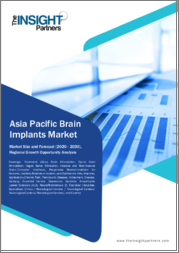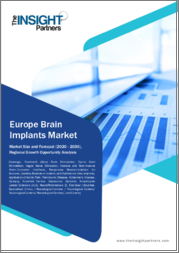
|
시장보고서
상품코드
1734896
세계의 뇌 임플란트 시장의 예측(-2032년) : 제품별, 용도별, 최종 사용자별, 지역별 분석Brain Implants Market Forecasts to 2032 - Global Analysis By Product, Application, End User and By Geography |
||||||
Stratistics MRC에 따르면 세계의 뇌 임플란트 시장은 2025년 74억 달러를 차지하고 예측 기간 동안 CAGR 11.9%로 성장하며 2032년까지 162억 6,000만 달러에 이를 전망입니다.
뇌 임플란트로 알려진 첨단 의료기기는 뇌에 직접 삽입되어 신경 조직과의 커뮤니케이션을 촉진합니다. 이 임플란트에는 많은 치료, 진단 및 강화 용도가 있습니다. 임플란트는 전극을 통해 전기 신호를 송수신함으로써 뇌의 활동을 포착하거나 유발합니다.
미국 신경외과학회(AANS)에 따르면, 미국에서는 약 25만명이 근육긴장이상증(불수의근 수축을 특징으로 하는 신경학적 운동장애)을 앓고 있습니다.
신경 질환의 유병률 증가
신경질환의 유병률은 세계에서 놀라운 속도로 증가하고 있습니다. 이상한 신경 활동을 제어하고 환자의 삶의 질을 높이는 것으로, 뇌 임플란트는 효율적인 개입을 제공합니다. 또한, 기존 치료에서는 특히 환자가 약제 저항성인 경우, 종종 실패하기 때문에 이식형 신경 자극 장치의 필요성은 높아지고 있습니다.
비싼 절차와 장비
뇌심부 자극(DBS) 시스템 및 기타 뇌 임플란트는 고액이며, 수술 비용이나 수술 후 비용을 고려하지 않으면 환자 1인당 35,000달러에서 50,000달러의 비용이 듭니다. 선진국에서도 보험 적용이 제한되어 있을 수 있으며, 이는 환자가 이러한 치료를 선택하는 것을 망설이고 있습니다.
BCI(브레인 컴퓨터 인터페이스) 성장
브레인 컴퓨터 인터페이스(BCI)는 뇌 임플란트와 외부 컴퓨팅 시스템을 통합하는 것으로, 헬스케어 및 기타 분야에서 혁명적인 가능성을 열고 있습니다. Synchron의 혈관내 BCI나 Elon Musk의 Neurallink와 같은 대처는 치료와 비의료의 양 분야에서 사용하기 위한 관심과 자금을 모으고 있습니다. 또한, 이러한 기술이 발전해, 커뮤니케이션, 게임, 스마트 디바이스, 확장 인지 등의 분야에서 상업 이용 가능하게 되면, 뇌 임플란트 시장은 기존의 의료
윤리적 반발과 일반 시민의 회의심
기술적 가능성에도 불구하고 윤리적, 철학적 문제로 인해 세상은 여전히 뇌 임플란트에 회의적입니다. 이런 이유로 인간의 뇌의 신성함이 매우 중시되는 사회에서는 침습적인 처치가 종종 저항됩니다. 또한 뇌 임플란트가 기능 강화와 치료를 혼동하기 시작하면 윤리적 경계나 남용의 가능성에 대한 논의가 높아져 시장에 따라 규제와 금지가 이루어질 수도 있습니다.
COVID-19의 영향:
COVID-19의 대유행은 뇌 임플란트 시장에 다양한 영향을 미쳤습니다. 초기 시장 혼란에는 공급망 혼란, 병원 수용 능력 저하, 선택적 뇌신경 수술 연기 등의 결과로 임플란트 수술과 임상시험이 일시적으로 감소한 것이 포함됩니다. 원격 모니터링 및 만성 질환 관리를 위한 최첨단 솔루션에 주목하는 동안, 유행은 신경 기술과 디지털 건강에 대한 투자를 가속화했습니다.
예측기간 동안 뇌심부자극장치(DBS) 분야가 최대가 될 전망
예측기간 동안 뇌심부자극장치(DBS) 분야가 최대 시장 점유율을 차지할 것으로 예측됩니다. FDA 승인이 끝나고, 확립되고, 풍부한 임상 데이터에 지지되고 있어 장치의 소형화, 배터리 수명, MRI 적합성에 있어서 기술 혁신이 진행되고 있기 때문에 그 채용은 더욱 진행되고 있습니다.
예측 기간 동안 우울증 분야의 CAGR이 가장 높아질 전망
예측 기간 동안 우울증 분야는 신경조절 요법이 받아들여지고 있으며 치료 저항성 우울증(TRD)의 이환율이 상승하고 있기 때문에 가장 높은 성장률을 나타낼 것으로 예측됩니다. 현재 진행중의 임상시험과 기분조절을 위해 설계된 폐루프 시스템의 개발로 임베디드 솔루션에 대한 관심이 높아지고 있습니다.
최대 점유율을 차지하는 지역
예측기간 중 북미지역이 최대 시장 점유율을 차지할 것으로 예상되며, 그 대부분은 미국이 견인하고 있어 세계 시장의 수익에 크게 공헌하고 있습니다. 북미의 우위는 톱 기업의 존재, 유리한 상환 관행, 진행 중인 R&D 이니셔티브에 기인하고 있습니다.
CAGR이 가장 높은 지역:
예측 기간 동안 아시아태평양이 가장 높은 CAGR을 나타낼 것으로 예측됩니다. 이것은 신경 질환의 발생률 상승, 투자 증가, 건강 인프라의 신속한 개선 등이 배경에 있습니다. 헬스케어 시스템의 개선을 목적으로 한 정부의 프로그램이나 투자도, 시장의 확대를 뒷받침하고 있습니다. 또한, 이 지역은 환자 인구가 많아, 가처분 소득이 증가하고 있기 때문에 향후의 성장이 매우 유망한 시장이며, 뇌 임플란트 기술의 채용에도 영향을 주고 있습니다.
무료 주문을 받아서 만드는 서비스:
이 보고서를 구독하는 고객은 다음 무료 맞춤설정 옵션 중 하나를 사용할 수 있습니다.
- 기업 프로파일
- 추가 시장 기업의 종합적 프로파일링(3개사까지)
- 주요 기업의 SWOT 분석(3개사까지)
- 지역 세분화
- 고객의 관심에 응한 주요국 시장 추계, 예측, CAGR(주: 타당성 확인에 따름)
- 경쟁 벤치마킹
- 제품 포트폴리오, 지리적 존재, 전략적 제휴에 기반한 주요 기업 벤치마킹
목차
제1장 주요 요약
제2장 서문
- 개요
- 이해관계자
- 조사 범위
- 조사 방법
- 데이터 마이닝
- 데이터 분석
- 데이터 검증
- 조사 접근
- 조사 정보원
- 1차 조사 정보원
- 2차 조사 정보원
- 전제조건
제3장 시장 동향 분석
- 성장 촉진요인
- 억제요인
- 기회
- 위협
- 제품분석
- 용도 분석
- 최종 사용자 분석
- 신흥 시장
- COVID-19의 영향
제4장 Porter's Five Forces 분석
- 공급기업의 협상력
- 구매자의 협상력
- 대체품의 위협
- 신규 참가업체의 위협
- 경쟁 기업간 경쟁 관계
제5장 세계의 뇌 임플란트 시장 : 제품별
- 뇌심부 자극장치
- 미주 신경 자극
- 반응성 신경 자극
제6장 세계의 뇌 임플란트 시장 : 용도별
- 만성 통증
- 간질
- 파킨슨병
- 우울
- 알츠하이머병
- 본태성 진전
- 기타 용도
제7장 세계의 뇌 임플란트 시장 : 최종 사용자별
- 병원
- 신경과 클리닉
- 기타 최종 사용자
제8장 세계의 뇌 임플란트 시장 : 지역별
- 북미
- 미국
- 캐나다
- 멕시코
- 유럽
- 독일
- 영국
- 이탈리아
- 프랑스
- 스페인
- 기타 유럽
- 아시아태평양
- 일본
- 중국
- 인도
- 호주
- 뉴질랜드
- 한국
- 기타 아시아태평양
- 남미
- 아르헨티나
- 브라질
- 칠레
- 기타 남미
- 중동 및 아프리카
- 사우디아라비아
- 아랍에미리트(UAE)
- 카타르
- 남아프리카
- 기타 중동 및 아프리카
제9장 주요 발전
- 계약, 파트너십, 협업, 합작투자
- 인수합병
- 신제품 발매
- 사업 확대
- 기타 주요 전략
제10장 기업 프로파일링
- Boston Scientific Corporation
- Medtronic plc
- Synchron Inc.
- Abbott Laboratories
- NeuroPace, Inc.
- LivaNova Plc
- Precision Neuroscience Inc
- NDI Medical LLC
- Renishaw PLC
- Aleva Neurotherapeutics SA
- Beijing PINS Medical Co., Ltd
- Functional Neuromodulation, Ltd.
- SceneRay Co., Ltd
- Cyberonics, Inc.
- NeuroSigma Inc
According to Stratistics MRC, the Global Brain Implants Market is accounted for $7.40 billion in 2025 and is expected to reach $16.26 billion by 2032 growing at a CAGR of 11.9% during the forecast period. Advanced medical devices known as brain implants, when inserted directly into the brain, facilitate communication with neural tissue. Numerous therapeutic, diagnostic, and enhancement applications exist for these implants. They work by capturing or triggering brain activity, frequently by sending and receiving electrical signals via electrodes. The safety, functionality, and possible uses of brain implants have been greatly enhanced by recent developments in materials science, wireless technology, and machine learning.
According to the American Association of Neurological Surgeons (AANS), approximately 250,000 individuals in the U.S. are affected by dystonia, a neurological movement disorder characterized by involuntary muscle contractions.
Market Dynamics:
Driver:
Increasing neurological disorder prevalence
The prevalence of neurological disorders is rising at a startling rate worldwide. Millions of people worldwide suffer from conditions like epilepsy, Parkinson's disease, Alzheimer's, chronic pain, and depression that don't go away. For example, according to estimates from the World Health Organization (WHO), more than 50 million people worldwide have epilepsy. By controlling aberrant neural activity and enhancing patients' quality of life, brain implants provide an efficient intervention. Moreover, the need for implantable neurostimulation devices is growing since traditional treatments frequently fail, particularly in cases where the patient is drug-resistant.
Restraint:
Expensive procedures and equipment
Deep brain stimulation (DBS) systems and other brain implants are costly; without accounting for surgical and postoperative costs, they can cost anywhere from $35,000 to $50,000 per patient. An important obstacle to access is the high initial and ongoing costs, especially in low- and middle-income nations. Insurance coverage may be restricted, even in developed areas, which deters patients from choosing such treatments. Additionally, the cost burden also affects healthcare systems, particularly when long-term monitoring, device upkeep, and possible issues necessitating adjustments are taken into account.
Opportunity:
Growth of BCIs (brain-computer interfaces)
Brain-computer interfaces (BCIs) are integrating brain implants with external computing systems, opening up revolutionary possibilities in healthcare and other fields. Through the use of brain-computer interfaces (BCIs), people who have lost limbs or are paralyzed can use neural signals to operate computers, wheelchairs, and prosthetic limbs. Initiatives like Synchron's endovascular BCIs and Elon Musk's Neuralink are garnering interest and funding for use in both therapeutic and non-medical fields. Furthermore, the market for brain implants may be greatly expanded outside of traditional medical settings as these technologies develop and find commercial use in communication, gaming, smart devices, and augmented cognition.
Threat:
Ethical backlash and public skepticism
The public is still skeptical of brain implants despite their technological potential because of ethical and philosophical issues. Advocacy groups and patients may find it difficult to accept someone who has mind control, loses autonomy, or changes their personality. In societies where the sanctity of the human brain is highly valued for religious or cultural reasons, invasive procedures are frequently resisted. Moreover, as brain implants start to conflate enhancement and treatment, there is growing discussion about ethical boundaries and possible abuse, which may result in restrictions or prohibitions in some markets.
Covid-19 Impact:
The COVID-19 pandemic affected the market for brain implants in a variety of ways. Initial market disruptions included a temporary drop in implant procedures and clinical trials as a result of supply chain disruptions, hospital capacity reductions, and the postponement of elective neurosurgeries. However, as healthcare systems looked into cutting-edge solutions for remote patient monitoring and chronic disease management, the pandemic also accelerated investments in neuro-technology and digital health. Additionally, long-term market growth is also anticipated due to the increased prevalence of neurological complications linked to prolonged COVID, such as brain fog, stroke, and cognitive dysfunction.
The deep brain stimulator (DBS) segment is expected to be the largest during the forecast period
The deep brain stimulator (DBS) segment is expected to account for the largest market share during the forecast period. DBS is the most widely used neuromodulation therapy, driven by its clinical success and widespread use in treating neurological disorders like Parkinson's disease, essential tremor, dystonia, and obsessive-compulsive disorder. It involves the implantation of electrodes in specific brain regions to deliver controlled electrical impulses, effectively modulating abnormal neural activity. Furthermore, it is FDA-approved, well-established, and supported by a wealth of clinical data, and its adoption is further enhanced by ongoing innovation in device miniaturization, battery life, and MRI compatibility.
The depression segment is expected to have the highest CAGR during the forecast period
Over the forecast period, the depression segment is predicted to witness the highest growth rate, driven by the growing acceptance of neuromodulation therapies and the rising incidence of treatment-resistant depression (TRD). Deep brain stimulation (DBS) and vagus nerve stimulation (VNS) are becoming viable substitutes for traditional antidepressants, which frequently fail to relieve a considerable percentage of patients. Interest in implantable solutions is being fueled by ongoing clinical trials and developments in closed-loop systems designed for mood regulation. Additionally, the COVID-19 pandemic's worsening of the mental health crisis has highlighted the need for novel treatments, spurring investment and research in this rapidly expanding field.
Region with largest share:
During the forecast period, the North America region is expected to hold the largest market share, mostly driven by the United States, which contributes significantly to global market revenue. High healthcare spending, a sophisticated healthcare infrastructure, and an increasing incidence of neurological conditions like depression, epilepsy, and Parkinson's disease all benefit the area. The dominance of North America is also attributed to the existence of top businesses, advantageous reimbursement practices, and ongoing R&D initiatives. Furthermore, driving market expansion in this area and establishing it as a major player globally is growing awareness of brain implants and their effectiveness in treating long-term neurological disorders.
Region with highest CAGR:
Over the forecast period, the Asia Pacific region is anticipated to exhibit the highest CAGR, driven by the rising incidence of neurological disorders, growing investments, and quick improvements in healthcare infrastructure. The need for cutting-edge medical technologies is rising in nations like China, India, and Japan as a result of aging populations, growing awareness of brain health, and easier access to healthcare. Government programs and investments meant to improve healthcare systems also encourage market expansion. Moreover, the region is a very promising market for future growth because of its large patient population and growing disposable incomes, which are also influencing the adoption of brain implant technologies.
Key players in the market
Some of the key players in Brain Implants Market include Boston Scientific Corporation, Medtronic plc, Synchron Inc., Abbott Laboratories, NeuroPace, Inc., LivaNova Plc, Precision Neuroscience Inc, NDI Medical LLC, Renishaw PLC, Aleva Neurotherapeutics SA, Beijing PINS Medical Co., Ltd, Functional Neuromodulation, Ltd., SceneRay Co., Ltd, Cyberonics, Inc. and NeuroSigma Inc.
Key Developments:
In April 2025, Medtronic plc announced a strategic agreement to distribute the advanced Dragonfly(TM)* pancreaticobiliary system from Dragonfly Endoscopy, Inc. in the United States. This innovative platform introduces significant enhancements in pancreaticobiliary endoscopy - a field where procedural standards have remained largely unchanged for decades. Financial terms of the agreement were not disclosed.
In March 2025, Boston Scientific Corporation announced it has entered into a definitive agreement to acquire SoniVie Ltd., a privately held medical device company that has developed the TIVUS(TM) Intravascular Ultrasound System. An investigational technology, the TIVUS system is designed to denervate nerves surrounding blood vessels to treat a variety of hypertensive disorders, including renal artery denervation (RDN) for hypertension.
In December 2024, Abbott Laboratories and DexCom said that they have reached an agreement to settle all patent disputes between them related to continuous glucose monitoring devices. The agreement will dismiss all pending cases in courts and patent offices worldwide, along with a provision preventing legal action between the companies for patent and appearance disputes for the next 10 years.
Products Covered:
- Deep Brain Stimulator
- Vagus Nerve Stimulation
- Responsive Neurostimulation
Applications Covered:
- Chronic Pain
- Epilepsy
- Parkinson's Disease
- Depression
- Alzheimer's Disease
- Essential Tremor
- Other Applications
End Users Covered:
- Hospitals
- Neurology Clinics
- Other End Users
Regions Covered:
- North America
- US
- Canada
- Mexico
- Europe
- Germany
- UK
- Italy
- France
- Spain
- Rest of Europe
- Asia Pacific
- Japan
- China
- India
- Australia
- New Zealand
- South Korea
- Rest of Asia Pacific
- South America
- Argentina
- Brazil
- Chile
- Rest of South America
- Middle East & Africa
- Saudi Arabia
- UAE
- Qatar
- South Africa
- Rest of Middle East & Africa
What our report offers:
- Market share assessments for the regional and country-level segments
- Strategic recommendations for the new entrants
- Covers Market data for the years 2024, 2025, 2026, 2028, and 2032
- Market Trends (Drivers, Constraints, Opportunities, Threats, Challenges, Investment Opportunities, and recommendations)
- Strategic recommendations in key business segments based on the market estimations
- Competitive landscaping mapping the key common trends
- Company profiling with detailed strategies, financials, and recent developments
- Supply chain trends mapping the latest technological advancements
Free Customization Offerings:
All the customers of this report will be entitled to receive one of the following free customization options:
- Company Profiling
- Comprehensive profiling of additional market players (up to 3)
- SWOT Analysis of key players (up to 3)
- Regional Segmentation
- Market estimations, Forecasts and CAGR of any prominent country as per the client's interest (Note: Depends on feasibility check)
- Competitive Benchmarking
- Benchmarking of key players based on product portfolio, geographical presence, and strategic alliances
Table of Contents
1 Executive Summary
2 Preface
- 2.1 Abstract
- 2.2 Stake Holders
- 2.3 Research Scope
- 2.4 Research Methodology
- 2.4.1 Data Mining
- 2.4.2 Data Analysis
- 2.4.3 Data Validation
- 2.4.4 Research Approach
- 2.5 Research Sources
- 2.5.1 Primary Research Sources
- 2.5.2 Secondary Research Sources
- 2.5.3 Assumptions
3 Market Trend Analysis
- 3.1 Introduction
- 3.2 Drivers
- 3.3 Restraints
- 3.4 Opportunities
- 3.5 Threats
- 3.6 Product Analysis
- 3.7 Application Analysis
- 3.8 End User Analysis
- 3.9 Emerging Markets
- 3.10 Impact of Covid-19
4 Porters Five Force Analysis
- 4.1 Bargaining power of suppliers
- 4.2 Bargaining power of buyers
- 4.3 Threat of substitutes
- 4.4 Threat of new entrants
- 4.5 Competitive rivalry
5 Global Brain Implants Market, By Product
- 5.1 Introduction
- 5.2 Deep Brain Stimulator
- 5.3 Vagus Nerve Stimulation
- 5.4 Responsive Neurostimulation
6 Global Brain Implants Market, By Application
- 6.1 Introduction
- 6.2 Chronic Pain
- 6.3 Epilepsy
- 6.4 Parkinson's Disease
- 6.5 Depression
- 6.6 Alzheimer's Disease
- 6.7 Essential Tremor
- 6.8 Other Applications
7 Global Brain Implants Market, By End User
- 7.1 Introduction
- 7.2 Hospitals
- 7.3 Neurology Clinics
- 7.4 Other End Users
8 Global Brain Implants Market, By Geography
- 8.1 Introduction
- 8.2 North America
- 8.2.1 US
- 8.2.2 Canada
- 8.2.3 Mexico
- 8.3 Europe
- 8.3.1 Germany
- 8.3.2 UK
- 8.3.3 Italy
- 8.3.4 France
- 8.3.5 Spain
- 8.3.6 Rest of Europe
- 8.4 Asia Pacific
- 8.4.1 Japan
- 8.4.2 China
- 8.4.3 India
- 8.4.4 Australia
- 8.4.5 New Zealand
- 8.4.6 South Korea
- 8.4.7 Rest of Asia Pacific
- 8.5 South America
- 8.5.1 Argentina
- 8.5.2 Brazil
- 8.5.3 Chile
- 8.5.4 Rest of South America
- 8.6 Middle East & Africa
- 8.6.1 Saudi Arabia
- 8.6.2 UAE
- 8.6.3 Qatar
- 8.6.4 South Africa
- 8.6.5 Rest of Middle East & Africa
9 Key Developments
- 9.1 Agreements, Partnerships, Collaborations and Joint Ventures
- 9.2 Acquisitions & Mergers
- 9.3 New Product Launch
- 9.4 Expansions
- 9.5 Other Key Strategies
10 Company Profiling
- 10.1 Boston Scientific Corporation
- 10.2 Medtronic plc
- 10.3 Synchron Inc.
- 10.4 Abbott Laboratories
- 10.5 NeuroPace, Inc.
- 10.6 LivaNova Plc
- 10.7 Precision Neuroscience Inc
- 10.8 NDI Medical LLC
- 10.9 Renishaw PLC
- 10.10 Aleva Neurotherapeutics SA
- 10.11 Beijing PINS Medical Co., Ltd
- 10.12 Functional Neuromodulation, Ltd.
- 10.13 SceneRay Co., Ltd
- 10.14 Cyberonics, Inc.
- 10.15 NeuroSigma Inc



















